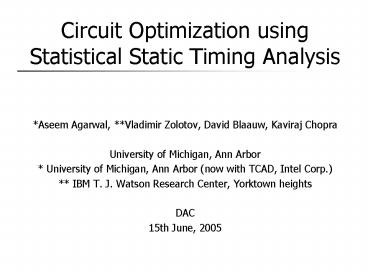Circuit Optimization using Statistical Static Timing Analysis - PowerPoint PPT Presentation
1 / 26
Title:
Circuit Optimization using Statistical Static Timing Analysis
Description:
At each node - convolve forward and backward PDFs. Compute remainder CDF (remainder ckt) Convolve perturbed, forward and backward PDFs. Max with the remainder CDF ... – PowerPoint PPT presentation
Number of Views:192
Avg rating:3.0/5.0
Title: Circuit Optimization using Statistical Static Timing Analysis
1
- Circuit Optimization using Statistical Static
Timing Analysis - Aseem Agarwal, Vladimir Zolotov, David Blaauw,
Kaviraj Chopra - University of Michigan, Ann Arbor
- University of Michigan, Ann Arbor (now with
TCAD, Intel Corp.) - IBM T. J. Watson Research Center, Yorktown
heights - DAC
- 15th June, 2005
2
Introduction
Incremental Processing
3
Traditional Approach - deterministic
- Optimization formulation Minimize the circuit
Area/Power - Constraint on circuit delay (timing yield) or
vice versa - Determine design variables (ex gate size)
- Outcome
- Improved power, area, delay, noise well tuned
circuit - Deterministic optimization delay is
non-statistical - Compute the sensitivity of the obj. fn. to design
variables using STA - Feed into Non-linear optimizer
- Process variation not properly accounted for
- Yield loss
- Need for a Statistically-aware optimizer
(statistical delay models)
4
The Wall An Uncorrelated Phenomenon
- Deterministic Optimization creates a so-called
timing-wall - No advantage in improving non-critical paths
- Degrade statistical performance
- Statistical Delay improvement (given a det. sized
ckt.) - With an additional area penalty
- Same nominal delay
- Iso-area
- Nominal delay increase possible
5
Prior Work
- Deterministic delay model based
- H. Hashimoto ISCAS 01
- Deterministic optimization creates a timing wall
- Height of the wall impacts the statistical delay
by large amt. - X. Bai DAC 02
- Provide incentive in the det. formulation to
avoid a wall - Statistical delay model based (Non-linear
programming problem) - E. Jacobs DATE 00
- Gaussian approximation for max (analytical
formulation) - Sensitivity computation complexity is O (n2 )
- S. Raj DAC 04
- Path based approach enum. all paths in worst
case - Demonstrate large improvements on benchmark ckts.
6
Optimization Objective
- Optimization changes both mean and shape of PDF
- Need measure of quality capture both
7
Brute-force formulation one opt. step
- Statistical objective function
- helps evaluate the change in the waveform
- Sensitivity Computation
- Complexity O(VE)
- Need faster sensitivity computation
8
1st Approach Perturbation Bounds
Arrival time CDFs
9
2nd Approach Slack Based heuristic
- One forward SSTA and one backward SSTA
computation - At each node - convolve forward and backward PDFs
- Compute remainder CDF (remainder ckt)
- Convolve perturbed, forward and backward PDFs
- Max with the remainder CDF
- Compare with circuit delay CDF to obtain
sensitivity - No need to run
- SSTA multiple
- times
10
Experimental setup and results
- Setup
- Synthesized ISCAS benchmark circuits (180 nm
library) - The delay model used is
- Compare w/ optimal solution obtained using MINOS
- Statistical timing run on the obtained circuit
- Area delay curves plotted for 800 sizing
iterations - Results
- With standard deviation 5 of mean delay
- Av. delay imp 3.8 , Av. sigma imp 8.5
11
Slack Based Efficiency
- 20 X run time improvement by 1st Approach, 142 X
improvement by 2nd Approach
12
Accuracy of SSTA vs M.C. c3540
13
Optimized circuit delay PDF - c880
14
Cost functions c880
15
Summary
- Optimization objective and Brute force
formulation - 1st Approach (Block level analysis)
- Theory of Perturbation Bounds to reduce O(n2)
complexity - 2nd Approach (Chip level analysis)
- Slack based heuristic
- Linear runtime imprv. upto 2 orders of
magnitude - Demonstrate significant timing imprv. comp. to
det.
16
- Thank You
17
- Backup Slides
18
Runtime Results
- 20 X by bound based prune, 89 X improvement by
combined approach
19
Optimization results 99 delay
- Av. delay imp 7.6 , Av. Sigma imp 17
20
3 different optimizations c6288
21
c880 Optimized circuit delay PDF
22
Accuracy of bounds c3540
23
Cost functions c880
24
Exact sensitivity computation
- can only diminish
- This property can be used for pruning
- Propagate a perturbation to the sink node
- Prune other gates in the circuit if they are
lesser - Reduces complexity
- Need to determine gates to be propagated first
- Greedy selection
- Level by level propagation
- Either provide sensitivities to a n.l.o or greedy
sizing
25
Outline of talk
- Need for Statistical Timing Based Optimization
- Our Contribution
- Different optimization objectives
- Brute force formulation
- 1st Approach
- 2nd Approach
- Results and Analysis
- Summary
26
Iso-area example for SSTO
- Critical and near-critical paths of a design
- Different standard deviations
- Size down low sigma paths / Size up high sigma
paths (one trade-off) - Decision made by the optimization objective































